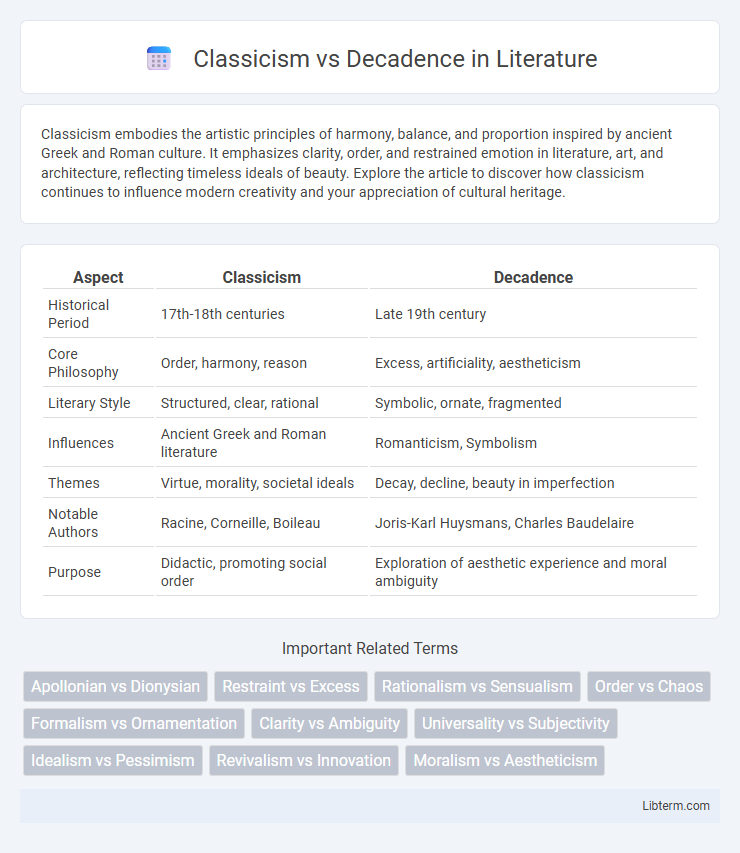Classicism embodies the artistic principles of harmony, balance, and proportion inspired by ancient Greek and Roman culture. It emphasizes clarity, order, and restrained emotion in literature, art, and architecture, reflecting timeless ideals of beauty. Explore the article to discover how classicism continues to influence modern creativity and your appreciation of cultural heritage.
Table of Comparison
| Aspect | Classicism | Decadence |
|---|---|---|
| Historical Period | 17th-18th centuries | Late 19th century |
| Core Philosophy | Order, harmony, reason | Excess, artificiality, aestheticism |
| Literary Style | Structured, clear, rational | Symbolic, ornate, fragmented |
| Influences | Ancient Greek and Roman literature | Romanticism, Symbolism |
| Themes | Virtue, morality, societal ideals | Decay, decline, beauty in imperfection |
| Notable Authors | Racine, Corneille, Boileau | Joris-Karl Huysmans, Charles Baudelaire |
| Purpose | Didactic, promoting social order | Exploration of aesthetic experience and moral ambiguity |
Introduction: Defining Classicism and Decadence
Classicism emphasizes harmony, clarity, and balanced proportions rooted in ancient Greek and Roman art and literature. Decadence, emerging in the late 19th century, reflects a fascination with excess, artificiality, and moral decline, often rejecting traditional values. These contrasting movements reveal differing cultural priorities: Classicism's order and reason versus Decadence's aestheticism and rebellion.
Historical Origins of Classicism
Classicism originated in the ancient civilizations of Greece and Rome, where emphasis on harmony, proportion, and balance defined art, literature, and architecture. Rooted in Enlightenment ideals, Classicism revived during the 17th and 18th centuries as a reaction against Baroque excess, favoring clarity, order, and restrained emotion. Philosophers like Johann Joachim Winckelmann and artists such as Nicolas Poussin championed classical principles, influencing European culture's enduring appreciation for antiquity's aesthetics.
The Rise and Influence of Decadence
The Rise and Influence of Decadence marked a significant departure from Classicism, emphasizing aestheticism, emotional excess, and a rejection of traditional moral values. Decadence, emerging in the late 19th century, challenged the rational harmony and order of Classicism by embracing themes of decline, artificiality, and sensory excess. This movement influenced literature, art, and culture, shaping modernist trends and questioning Enlightenment ideals.
Core Principles and Aesthetics of Classicism
Classicism emphasizes harmony, balance, and proportion drawn from Ancient Greek and Roman art and literature, promoting clarity and restraint as core principles. Its aesthetics focus on idealized beauty, symmetrical composition, and adherence to established rules that evoke timeless elegance and order. Classicism values rationality and discipline, contrasting with the emotional excess and ornamentation often seen in Decadence.
Decadent Art: Features and Philosophies
Decadent art emphasizes aestheticism, individualism, and a rejection of traditional moral values, often celebrating excess, artificiality, and sensual pleasure. It features elaborate detail, rich symbolism, and themes of decay, morbidity, and existential ennui, reflecting a disillusionment with modernity and conventional societal norms. Philosophically, decadence embraces subjectivity, irony, and a fascination with the transgressive, contrasting sharply with the order, harmony, and rationality revered by classicism.
Key Figures in Classicism and Decadence
Key figures in Classicism include Johann Joachim Winckelmann, whose archaeological and art historical work defined the classical ideal, and Nicolas Boileau, who codified literary rules emphasizing clarity, order, and harmony. Decadence is epitomized by figures such as Charles Baudelaire, whose poetry explored morbidity and beauty, and Joris-Karl Huysmans, whose novel "A rebours" became a manifesto for the Decadent movement. These authors illustrate the philosophical and aesthetic conflicts between Classicism's structured restraint and Decadence's embrace of excess and sensuality.
Classicism vs Decadence in Literature
Classicism in literature emphasizes clarity, harmony, and restraint, drawing inspiration from ancient Greek and Roman ideals that value order and rationality. Decadence, emerging in the late 19th century, embraces artificiality, excess, and moral ambiguity, often exploring themes of decline and aestheticism through rich, ornate language. The contrast between Classicism's structured form and Decadence's indulgent experimentation highlights evolving attitudes toward tradition and innovation in literary history.
Impact on Visual Arts and Architecture
Classicism in visual arts and architecture emphasized harmony, proportion, and adherence to ancient Greco-Roman principles, resulting in structures like the Pantheon-inspired neoclassical buildings and balanced compositions in painting. Decadence rejected these ideals by embracing ornate, exaggerated designs and rich symbolism, often seen in Art Nouveau and Symbolist movements that foregrounded aesthetic complexity and emotional intensity. The contrast between the two shaped cultural narratives by either reinforcing order and clarity or celebrating individualism and sensory experience in artistic expressions.
Societal Reflections: Morality and Culture
Classicism emphasizes order, rationality, and moral clarity, reflecting a society striving for harmony and ethical standards rooted in tradition and universal principles. Decadence, by contrast, highlights moral ambiguity, excess, and cultural decline, mirroring societal anxieties about decay, superficiality, and the erosion of established values. These opposing artistic movements reveal how morality and culture serve as barometers of societal health, with Classicism advocating stability and Decadence exposing disillusionment and fragmentation.
Enduring Legacy: Classicism and Decadence Today
Classicism's enduring legacy is evident in contemporary architecture, literature, and art, emphasizing harmony, proportion, and rationality that continue to inspire design and cultural values. Decadence influences modern aesthetics through its embrace of complexity, sensuality, and critique of conventional morality, shaping avant-garde movements and postmodern cultural expressions. Both movements contribute to ongoing dialogues in artistic innovation and cultural identity, reflecting timeless tensions between order and excess.
Classicism Infographic

 libterm.com
libterm.com